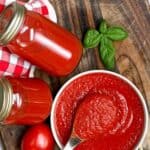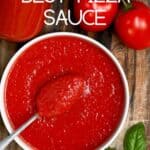This post may contain affiliate links. Please read our disclosure policy.
Make quick and delicious homemade pizza sauce in just 20 minutes with 6 ingredients. A freezer and canner-friendly sauce that tastes so much better than commercial versions!
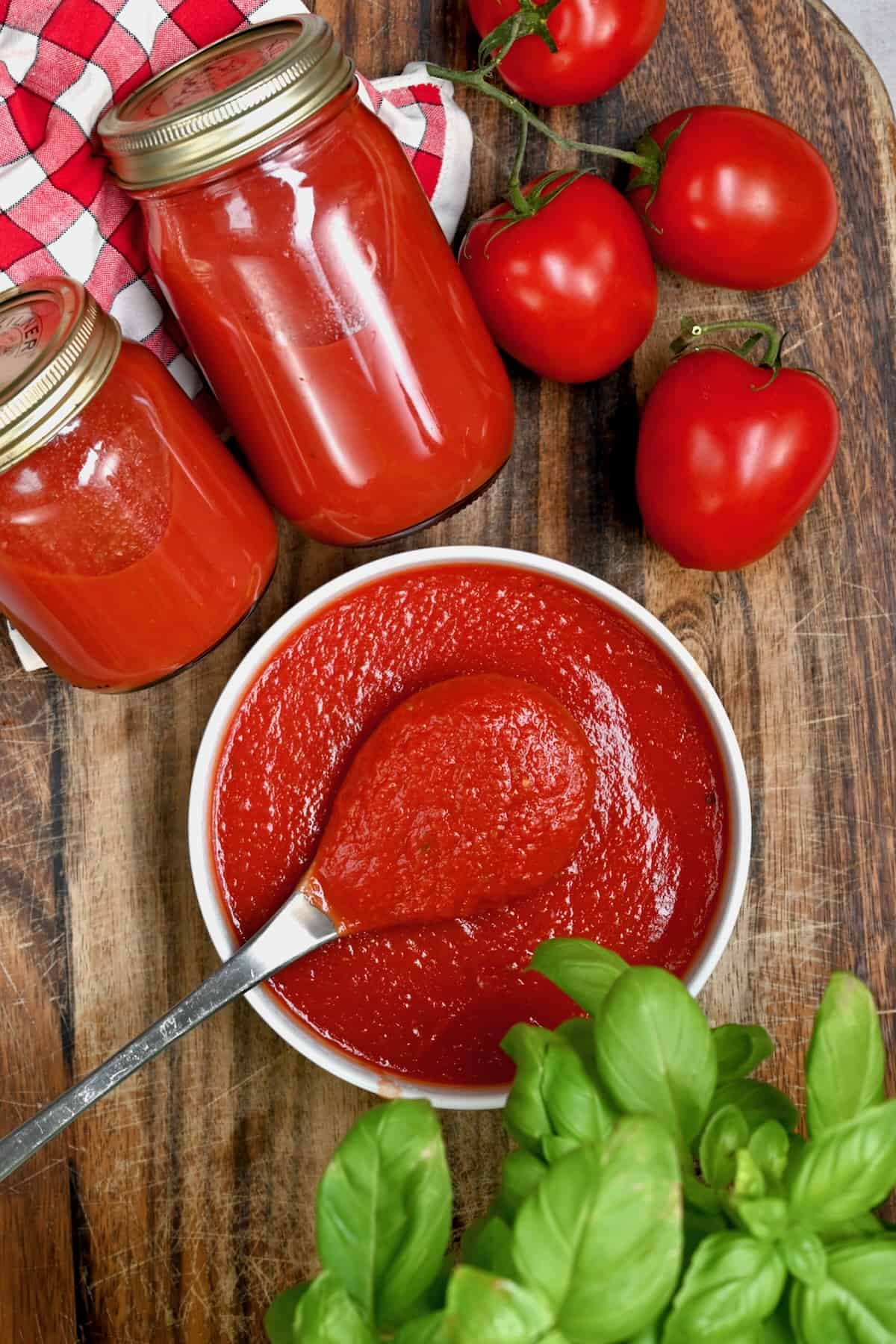
The next time you’re craving a delicious homemade Neapolitan pizza marinara style but turn to your pantry to discover there’s no pizza sauce there, don’t panic! You can learn how to make pizza sauce in 20 minutes from ingredients you probably already have – meaning no need to pop to the shops!
This easy pizza sauce is made with just 6 ingredients but tastes so much fresher and more delicious (especially if using homemade tomato puree) than most store-bought pizza sauce, and without the extra additives/preservatives that they often contain. It’s also a naturally gluten-free, dairy-free, vegan, keto sauce with no added sugar.
And while this pizza sauce recipe is admittedly not as quick to prepare as “5-minute no-cook” varieties, simmering the ingredients for just 15 minutes not only creates the best texture but provides time for the herbs to infuse for the BEST homemade pizza sauce! You can even water bath can it for shelf-stable pantry storage.

In no time at all, you’ll be slathering this made-from-scratch sauce over traditional homemade pizza dough, zucchini pizza bites, and calzones. That’s not all, though, as it’s also great in Italian meatballs, and eggplant parmesan and as a dipping sauce for breadsticks, fries, and air fryer chicken tenders.
Want to save this recipe?
Homemade Pizza Sauce Ingredients
- Tomato puree: I love using homemade tomato puree for the freshest flavor, especially when tomatoes are in season. However, store-bought puree will work, too.
If you can’t find/make tomato puree, use high-quality whole canned tomatoes (like San Marzano tomatoes) and use a blender to blend them into a puree. However, this version takes longer to simmer and may taste more acidic.
- Seasonings: There are just a few pantry staples needed to make the best recipe:
- Garlic powder: or fresh garlic. Sauté for 1 minute before adding the puree.
- Sea salt or kosher salt – NOT table salt.
- Black pepper.
- Dried oregano or Italian Seasoning/a combination of the two.
- Lemon juice: Just a little bottled or fresh lemon juice will make this recipe safe for canning since tomatoes alone can have varying acidity levels.
If you plan to water bath can the sauce, it’s best to use bottled lemon juice, which has a consistent pH (unlike fresh lemons, which can vary).

How to Make Homemade Pizza Sauce
Prepare the Tools
If you’re planning to water bath can the pizza sauce or store it in jars for a few days in the fridge, first sterilize the jars and all the tools. Washing them in hot, soapy liquid and leaving them to dry on a clean surface.
For canning, also prepare the canner by placing a trivet in the bottom of the canner/a heavy-based, deep pot and pour in enough water to cover the jars by at least an inch (once added).
Prepare the Sauce
Transfer half of the tomato puree to a large stainless-steel saucepan and bring it to a boil over high heat, stirring occasionally.
Maintaining a constant boil, add the remaining puree, a cup at a time, then stir in the remaining ingredients (garlic powder, oregano, salt, pepper, and lemon juice).
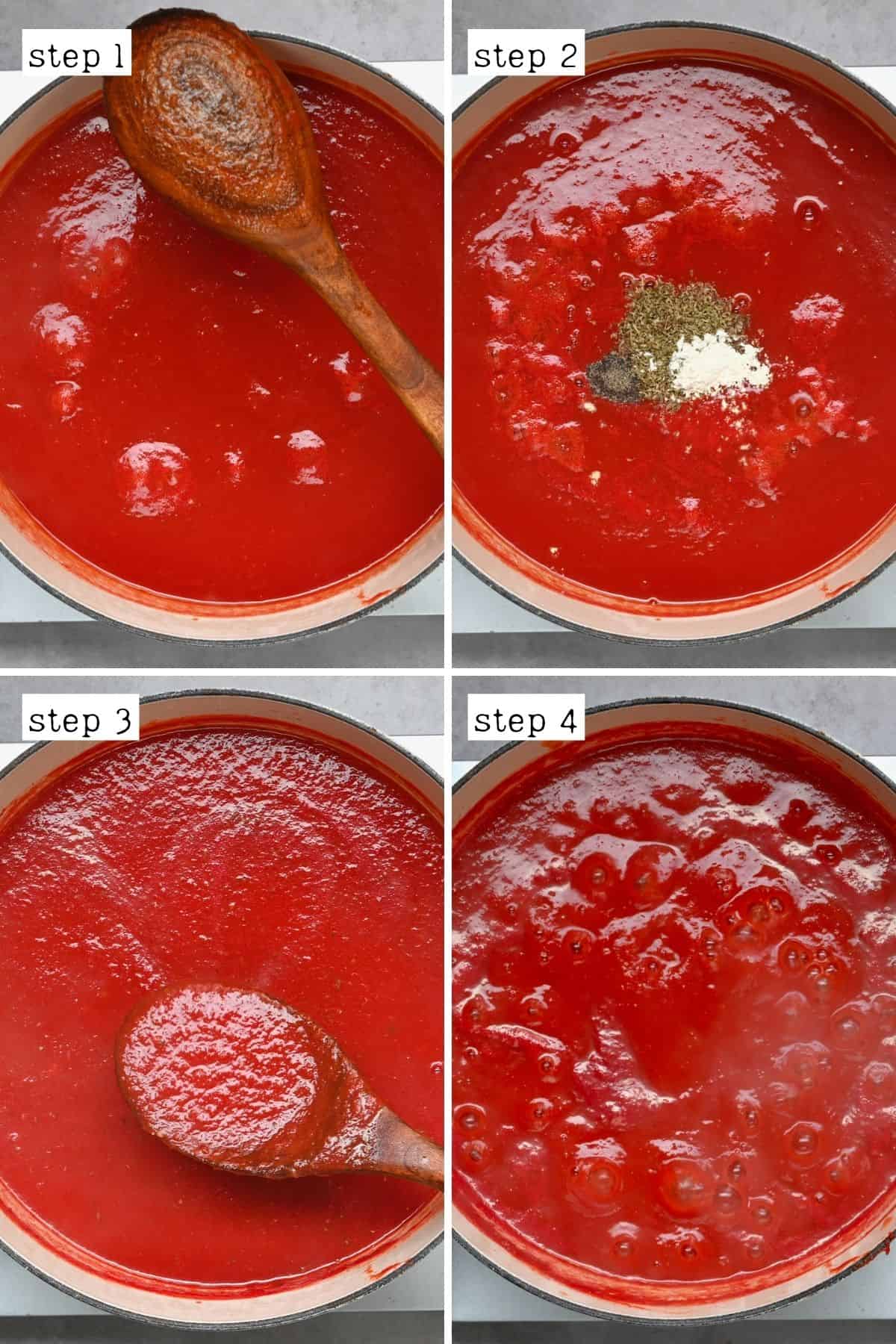
Continue to boil, stirring frequently, until the sauce has the consistency of a commercial pizza sauce (a spreadable consistency) – this should take about 15 minutes.
Finally, taste and adjust any of the seasonings. You can now use the sauce right away, transfer it to jars/airtight container and place it in the refrigerator for later, or water bath canning it for long-term shelf stable storage.
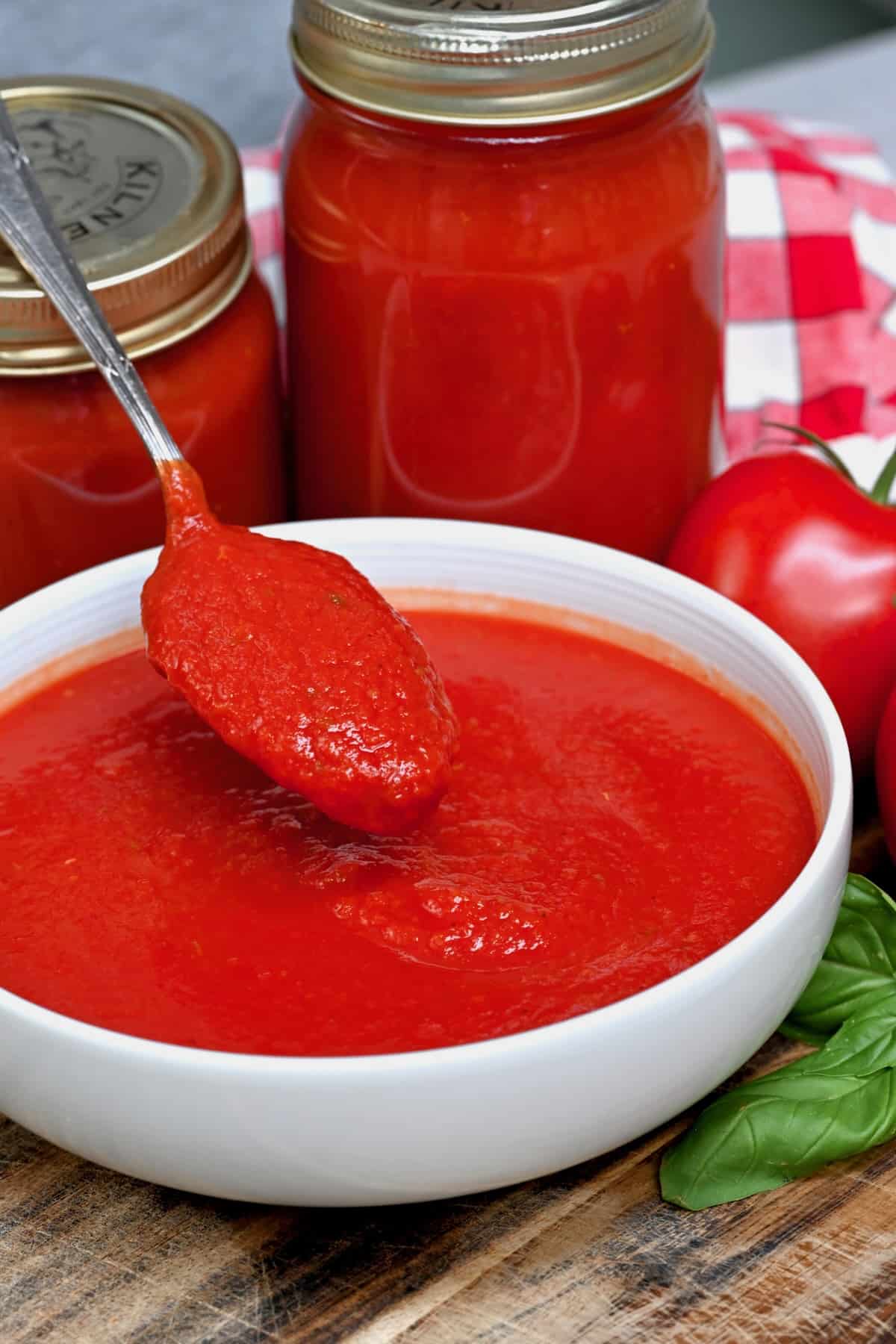
How Long Does Homemade Pizza Sauce Last in the Fridge?
If you aren’t planning to can the sauce, allow it to cool in the jars (or airtight container), then store them in the refrigerator (towards the back, where it’s coldest, is best) for up to 2 weeks.
The warm sauce in the jars CAN produce a kind of “seal” itself, helping it to last longer (before opening the jar), but this isn’t guaranteed.
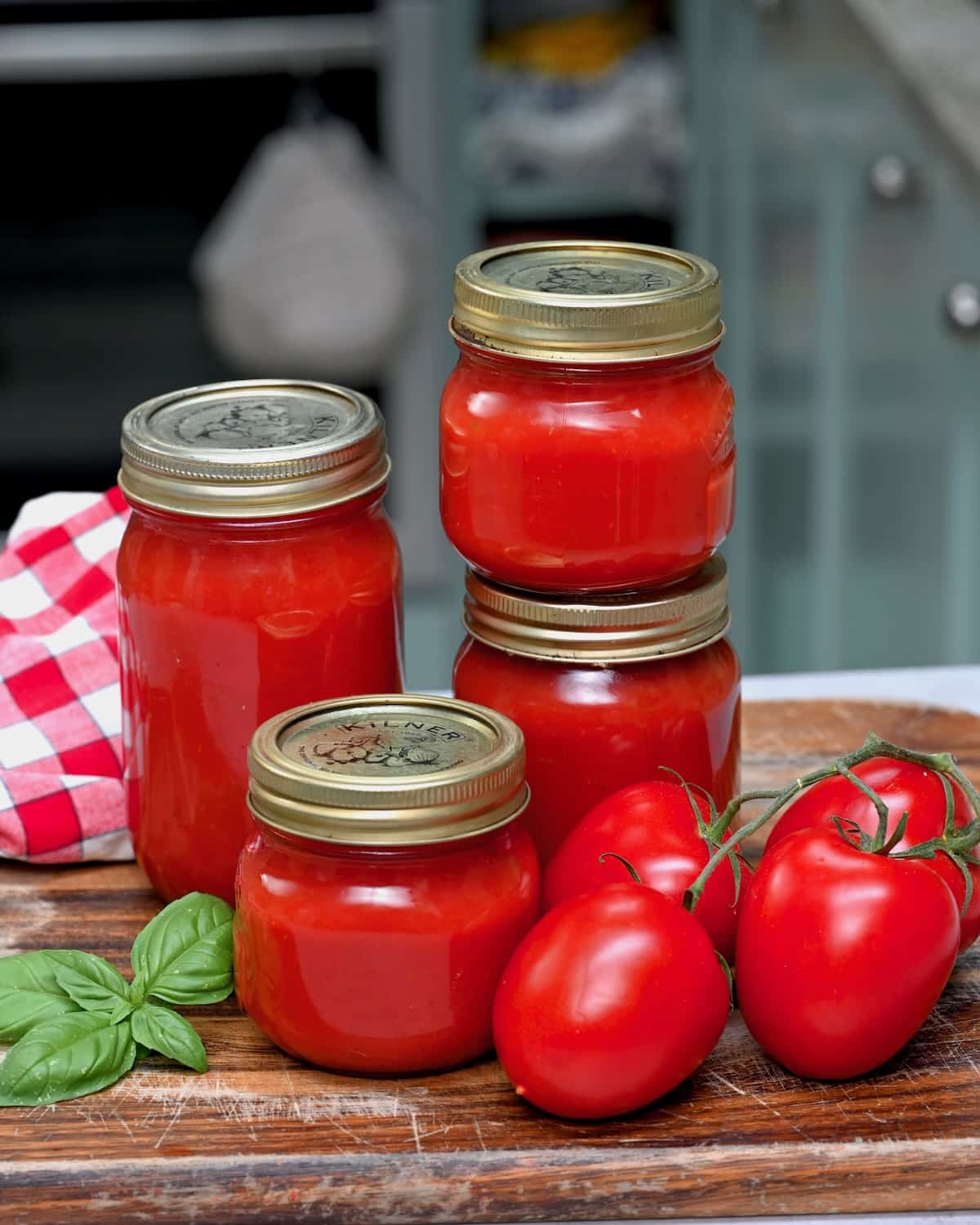
Canning Homemade Pizza Sauce
Make sure the jars are warm before filling them. To do so, while making the sauce, you can keep the jars (lids on) in the prepared canner and warm them up as you warm the water.
Ladle the hot sauce into the sterilized hot jars, leaving ½-inch (1 cm) headspace.
Tap the jars against the counter and/or use a clean knife to remove any air bubbles (which can cause early spoilage), then wipe the jar rims with a clean kitchen towel.
To secure the lids, place the center lid over the jar, screw the band until resistance is met, then increase until fingertip-tight.

Using canner tongs, carefully transfer the jars to the canner, ensuring they’re covered by at least 1 inch of water, then bring the water back to a boil.
Once boiling, add the lid and process the jars for 35 minutes (for 1000 ft or less) before removing the lid and leaving them for 5 minutes.
Adjust the processing time based on your altitude. For up to 3k, add 5 minutes, 6k – add 10 minutes, 8k – add 15, and 10k – add 20. Use a timer.
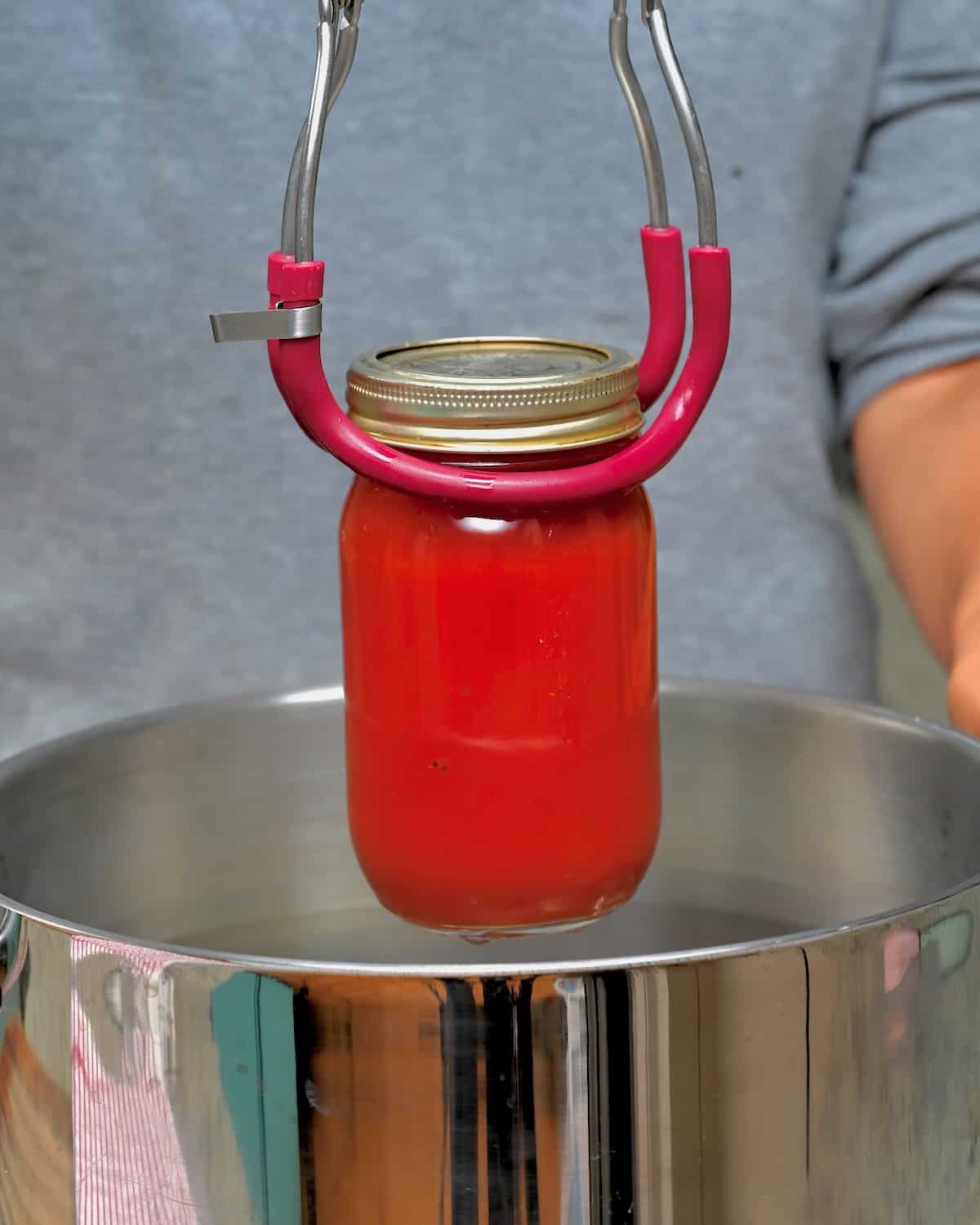
Finally, transfer the cans to a kitchen-towel-lined surface to fully cool, check the seal, and then store them in a cool, dark location for up to 18 months.
More Sauce Recipes
If you try this delicious, easy homemade pizza sauce recipe, let me know how it goes in the comments below. I’d appreciate a recipe card rating and would love to see your recipe recreations – tag me on Instagram @Alphafoodie!
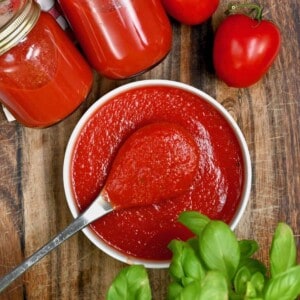
Quick Homemade Pizza Sauce Recipe
Equipment
- 3 Glass jars 1 pint each (16 oz/500 ml)
Ingredients
- 8 cups tomato puree I use homemade for the freshest flavor
- 1/2 tsp garlic powder or garlic cloves (saute for minute first)
- 1/4 tsp black pepper
- 1/2 tsp salt
- 1/2 Tbsp oregano or Italian seasoning
- 1/3 cup lemon juice fresh or bottled
Instructions
- If you're planning to water bath can the sauce or store it in jars for a few days in the fridge, first sterilize the jars and all the tools. Washing them in hot, soapy liquid and leaving them to dry on a clean surface.For canning, also prepare the canner by placing a trivet in the bottom of the canner/a heavy-based, deep pot and pour in enough water to cover the jars by at least an inch (once added).
- Transfer half of the tomato puree to a large stainless-steel saucepan and bring it to a boil over high heat, stirring occasionally.
- Maintaining a constant boil, add the remaining puree, a cup at a time, then stir in the remaining ingredients (garlic powder, oregano, salt, pepper, and lemon juice).
- Continue to boil, stirring frequently, until the sauce has the consistency of a commercial pizza sauce (a spreadable consistency) – this should take about 15 minutes.
- Taste and adjust any of the seasonings. You can now use the sauce right away, transfer it to jars/airtight container and place it in the refrigerator for later, or water bath canning it for long-term shelf stable storage.
Short-term storage
- Fridge: Allow it to cool in the jars (or airtight container), then store them in the refrigerator (towards the back, where it’s coldest, is best) for up to 2 weeks.Freezer: This sauce also freezes very well. I recommend dividing it into portions and spreading it flat in freezer-safe bags to freeze for up to 3 months. Leave it to thaw overnight in the refrigerator or break it up and reheat over low heat in a saucepan from frozen.
Long-term storage (water-bath canning)
- Make sure the jars are warm before filling them. To do so, while making the sauce, you can keep the jars (lids on) in the prepared canner and warm them up as you warm the water.
- Ladle the hot sauce into the sterilized hot jars, leaving ½-inch (1 cm) headspace.
- Tap the jars against the counter and/or use a clean knife to remove any air bubbles (which can cause early spoilage), then wipe the jar rims with a clean kitchen towel.
- To secure the lids, place the center lid over the jar, screw the band until resistance is met, then increase until fingertip-tight.
- Using canner tongs, carefully transfer the jars to the canner, ensuring they’re covered by at least 1 inch of water, then bring the water back to a boil.
- Once boiling, add the lid and process the jars for 35 minutes (for 1000 ft or less) before removing the lid and leaving them for 5 minutes.Adjust the processing time based on your altitude- For up to 3k, add 5 minutes, 6k add 10 minutes, 8k add 15, and 10k add 20. Use a timer.
- Transfer the cans to a kitchen-towel-lined surface to fully cool, check the seal, and then store them in a cool, dark location for up to 18 months.
Video
Notes
- Use high-quality ingredients: I love making homemade tomato puree from fresh, ripe, in-season tomatoes. If not, use high-quality commercial puree.
- “Cheat” quick pizza sauce method: Use a combination of tomato puree and tomato paste instead of all puree for a thicker consistency and more condensed flavor that only requires a few minutes of simmering. Remember, you only need 1/3 the amount when replacing puree with tomato paste. Add just 1 Tbsp tomato paste for richness.
- For more flavor: Optionally temper half or all the dried herbs in a tablespoon of oil before adding the first half of the puree to the pan.
- The yield may vary: Based on how long you simmer the sauce, as it will continue to reduce as it thickens.
- If it’s “tinny”/acidic: Add a pinch of (or slightly more) sugar, sugar replacement, honey, or maple syrup.
- Make it ahead when possible: This gives all the flavors more time to meld, improve, and intensify.
- Onion powder (for a more aromatic flavor),
- Dried basil (or fresh basil finely ribboned), thyme, and/or marjoram,
- Smoked paprika (for a subtle smoky flavor),
- Chili powder, red pepper flakes, or cayenne powder (for heat),
- Balsamic vinegar (for tangy brightness and more complex flavor),
- Soy sauce or tamari if gluten-free (instead of salt for extra umami flavor),
- Sugar or honey/maple syrup (if the tomato flavor is too acidic),
- A small amount of extra-virgin olive oil or butter (stir in at the end to create a smoother, richer, silkier mouthfeel).
Nutrition
Nutrition information is automatically calculated, so should only be used as an approximation.

